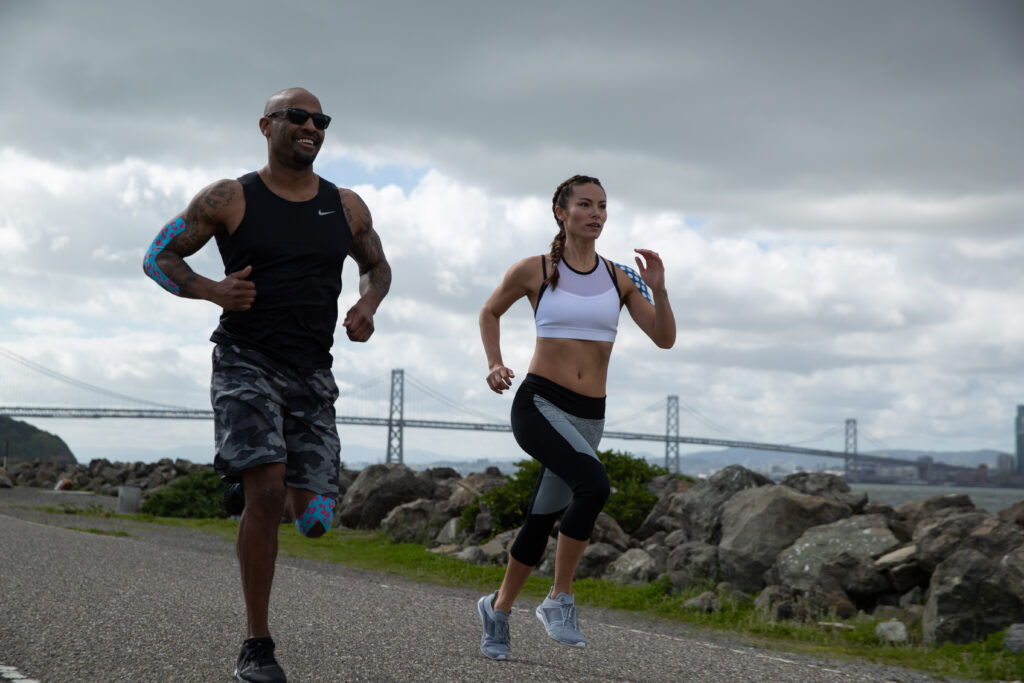Follow along with Winnipeg RockDoc Tyler Chliboyko from the Wellness Institute for his pre-run mobility session using RockFloss, RockBalls Infinity and RockTape kinesiology tape.
Whether you’re new to running, or a regular trailblazer, it’s always best to take the time to set aside some time pre- or post-run for mobility work. For this Sports Massage Therapist to go stronger longer, the ankles, feet and lateral chain take priority in a proper warm-up.
Starting with the ankles, Chilboyko pairs a 50/50 RockFloss application (50% stretch and 50% overlap) from the middle of the foot up to the lower calf with some simple range of motion exercises, followed by some unloaded and loaded bodyweight movements, like lunges and calf raises.
Learn more about how to use and apply RockFloss to the ankle here.
This RockDoc opts for RockBalls Infinity to quickly treat tight hamstrings and warm up his feet before a long run. Check out the spiky and smooth set of RockBalls mentioned in this video here.
Lastly, Chilboyko tapes his lateral chain with RockTape kinesiology tape to support a weak hip.
Common Running Injuries
…and how to tape for them

Runner’s Knee
Knee problems and running go hand-in-hand, unfortunately. And “runner’s knee” is such a generic term that it can’t even be considered a real diagnosis. Sadly, a lot of healthcare providers are not great at diagnosing knee problems and, as you can imagine, trying to treat something when you’re not sure what the problem is in the first place is a recipe for a lot of wasted time and effort.
For runners, knee pain usually comes in two varieties: patellar tendinosis and patellofemoral pain. These are two varieties of what amounts to a knee that just plain hurts to run or walk on.
Watch this video tutorial for applying RockTape kinesiology tape to the knee.
Shin Splints
The application for “shin splints”, more accurately known as “medial tibial stress syndrome” (or MTSS), is one that we continually get positive feedback about at Rocktape HQ. This application has helped many runners get back to training and racing more quickly. To apply the tape for MTSS, the troublesome muscle along the inside of the shin bone needs to be stretched. To do this the foot should be pulled back towards you (ankle dorsiflexed) and turned outwards (everted). Along the shin, our aim is to lay the tape half on the muscle and half on the bone- sometimes it is easier to make small marks with a pen before you start to guide you. Halfway up the shin, find the inside edge of the shin bone and make a pen mark one inch either side, then the 50mm tape should go just over these marks.
Watch this video tutorial for applying RockTape kinesiology tape for shin splints.
Weak or Sprained Ankles
When it comes to ankle sprains, RockTape kinesiology tape can be used immediately after the injury to help decrease swelling and also add stability so you feel like walking more, and more naturally. This helps you avoid some of the movement dysfunction that can be associated with this type of injury.
Watch this video tutorial for applying RockTape kinesiology tape to the ankle.
IT Band Pain
Trail running requires a lot of stability, as well as movability over uneven surfaces, and this can beat up the iliotibial band (ITB) just as much as pavement running. IT band pain usually manifests itself as outer knee pain, but it can sometimes be more predominant in the hip area. In both cases, tape one long strip from a few inches below the knee to a couple inches above the hip joint, then apply the smaller decompression strip right over the site of greatest pain. Feel free to use multiple decompression strips when needed.
Watch this video tutorial for applying RockTape kinesiology tape to the IT Band.